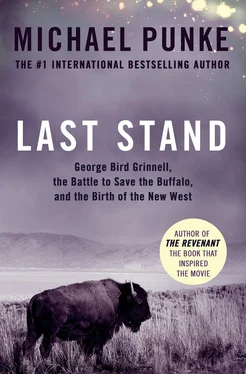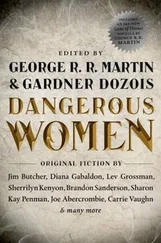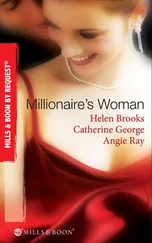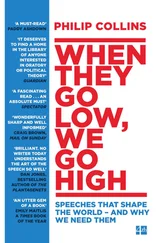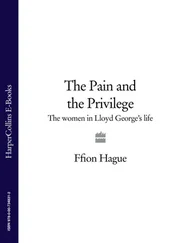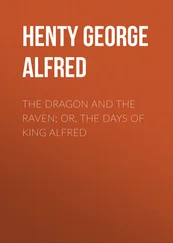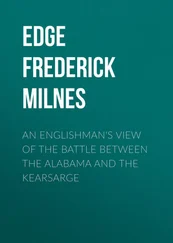There were no buffalo of any shade near Audubon Park, but Grinnell found many opportunities to act out the scenes he devoured from the books of Captain Reid. “It must have been 1860, or possibly 1861, when I was eleven or twelve years old, that I first began to go shooting.” Knowing that his parents would disapprove, Grinnell and a friend began secretly borrowing an old military musket from the village tailor. The gun was far taller than either boy and was so heavy that “neither could hold it to the shoulder” by himself. They took turns firing by having one boy, the shooter, rest the gun on the other’s shoulder. No creature was safe. “Small birds were the chief game pursued … meadowlarks, robins, golden winged woodpeckers and occasionally a wild pigeon.” Later one of Grinnell’s uncles legitimized the hunting activity when he gave Grinnell a small shotgun of his own. 9
In Grinnell’s writings about his childhood, no topic receives more attention than hunting. Indeed hunting became Grinnell’s most important early connection to the wild world, teaching him skills in the close observation of nature. Hunting also provided a new tie to the Audubon family. One of Grinnell’s frequent field companions was Jack Audubon, grandson of the painter. The connection went deeper still. Jack, in Grinnell’s words, “was privileged” with carrying his grandfather’s rifle—the same weapon that John James Audubon had relied upon during his epic adventures across the Mississippi. 10
Audubon Park steeped young George Bird Grinnell in other icons of the West, a “region which in those days seemed infinitely remote and romantic with its tales of trappers, trading posts and Indians.” The houses of Audubon’s two sons were like museums, their walls adorned with trophies of deer and elk, powder horns, and ball pouches. A portrait of the buckskin-clad artist stared down, along with dozens of his paintings. In the barn, where the boys often played, were “great stacks of the old red, muslin-bound ornithological biographies and boxes of bird skins collected by the naturalist, and coming from we knew not where.” Because the artist’s sons carried on his work, they corresponded with scientists from around the world, and “frequently received boxes of fresh specimens.” Grinnell remembered crowding around newly arrived shipments with his friends, waiting breathlessly for the cartons to be opened, then gazing in wonder at the “strange animals that were revealed.” 11
Of all the members of the Audubon family, none would exert greater influence on the young Grinnell than Lucy, the septuagenarian widow of the artist. Grinnell described her as “a beautiful white-haired old lady with extraordinary poise and dignity; most kindly and patient and affectionate, but a strict disciplinarian and one of whom all the children stood in awe.” From her bedroom she ran a school for the children of the neighborhood. Some of them were her grandchildren; all of them called her “Grandma Audubon.” 12
Lucy Audubon appears to have been one of those unique teachers—a lucky person might encounter one or two—who changes the lives of their students. She understood the children she taught, grasping the significance of those fleeting moments of connection when an educator has an opportunity to impress a young mind. “If I can hold the mind of a child to a subject for five minutes,” she said, “he will never forget what I teach him.” 13George Bird Grinnell, certainly, would always remember.
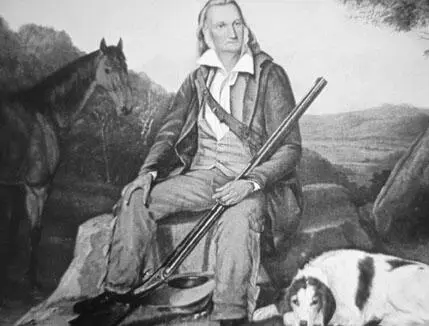
John James Audubon: Grinnell spent his childhood roaming the grounds of the (then rural) New York estate of the former painter-naturalist.
Courtesy of the National Park Service.
Some of the lessons were mundane: reading, writing, and ’rithmetic. Others were more unique: Lucy Audubon had worked closely with her husband on some of his later writings, including his Ornithological Biography . The experience had given her a solid exposure to natural science, a knowledge she passed on to her pupils. This knowledge—and Grinnell’s close relationship with his teacher—were on display in a story Grinnell later recounted about a time he captured a live bird in a net. “I rushed into the house and up to Grandma’s room, and showed her my prize. She told me that the bird was a Red Crossbill—a young one—pointed out the peculiarities of the bill, told me something about the bird’s life, and later showed me a picture of it. Then after a little talk she and I went downstairs and out of doors, found the birds still feeding there, and set the captive free.” 14
Some of the lessons that Grinnell learned from Lucy Audubon—including the one that would later emerge as the central creed of his life—would not register for years. Indeed from the time Grinnell left the school of Grandma Audubon to the time he graduated from college, his life had the feeling of casual indifference and missed opportunity.
His wealthy parents sent him to the best secondary schools. In 1861, when George was 12, he began a two-year stint at Manhattan’s French Institute. At age 14 he enrolled in the prestigious Churchill Military School at Sing Sing. Churchill enforced a mild form of military discipline, but the accommodations were hardly spartan. The supplies that new students were instructed to bring to school included “napkin ring, bathrobe and slippers, mackintosh and umbrella, sponge and nail file.” For three years, Grinnell went obediently through the well-defined motions of the school. He eventually rose up the ranks to command a company of his fellow students, but his academic performance was middling at best. Grinnell’s self-appraisal was both insightful and blunt: “I knew very well that I had wasted my time at school.” 15
Nor did Grinnell have any sense of direction, a passive actor in setting the course of his life. “It had been determined that, when I left school, I should go to Yale, where my grandfather had graduated in 1804, and others of my ancestors had associations.” Even with family connections, Grinnell’s academic credentials made admission to Yale a dubious proposition. Grinnell’s instructors at Churchill warned him that he was not prepared to pass Yale’s rigorous entrance exams. But “my parents had made up their minds, and I was not in the habit of questioning my father’s decisions.” Grinnell spent the summer of 1866 in tedious remedial review. In September he traveled to New Haven and just managed to gain entrance, though “I had conditions in Greek and in Euclid.” 16
Having successfully put his nose to the grindstone to win admittance, Grinnell found that his lackadaisical attitude toward his education quickly resurfaced once on campus. “Little of interest happened” was his summary of his freshman year. Grinnell’s sophomore year was more interesting because, as he explained, “I was perpetually in trouble.” He did find application for his outdoor skills, climbing up the lightning rod of a campus clock tower in order to inscribe his class number at the top. Grinnell was also an enthusiastic participant in “all the hazing and hat-stealing which was usual by Sophomores.” Partway through the fall semester, Grinnell was “detected in hazing a Freshman, and was suspended for one year.”
Grinnell, along with a few fellow transgressors, was exiled to Farmington, Connecticut. Their supervisor in Farmington, one Reverend L.R. Payne (Yale ’59), was responsible for tutoring the boys and, presumably, guiding them back to a more responsible path. Contrition, however, was in short supply among Grinnell and his comrades. “At Farmington we had a very good time, doing very little studying, and spending most of our time out of doors.” It was almost like being back at Audubon Park. “We took long walks, paddled on the Farmington River, and on moonlight nights in winter used to spend pretty much all night tramping over the fields.” At the end of the school year, Yale gave Grinnell the opportunity to take the exams with his class, but “[m]y idleness at Farmington resulted in a failure to pass.”
Читать дальше
